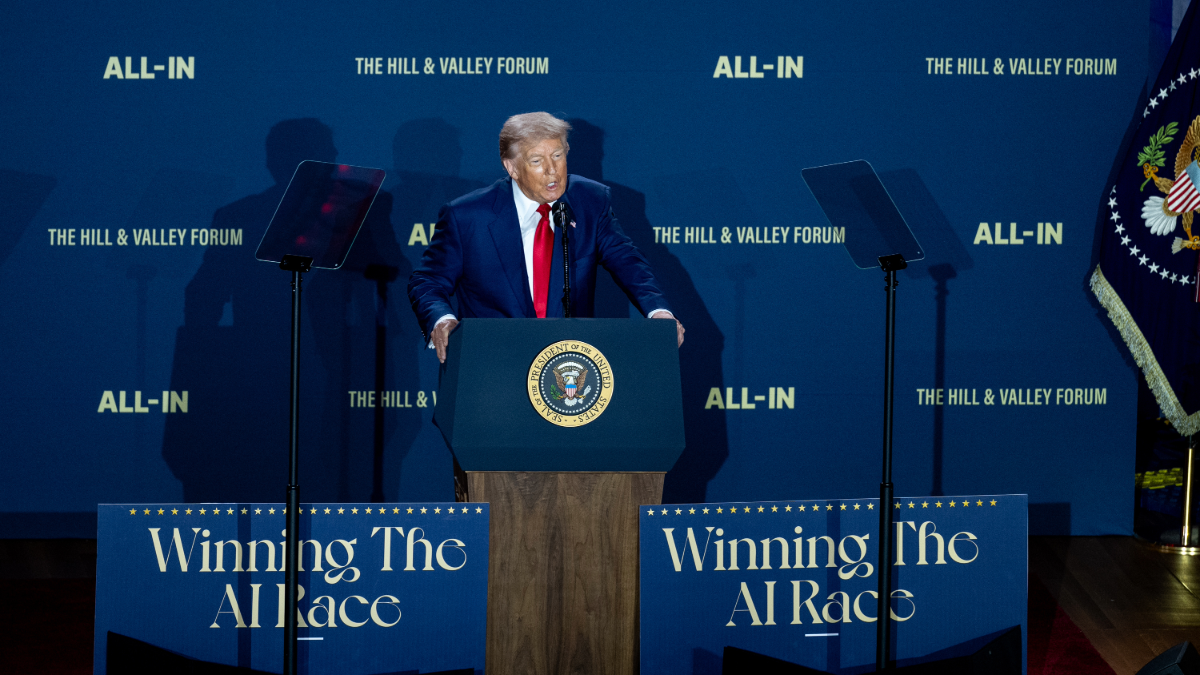Trump’s AI Plan Promises Jobs, Not A Seat at the Table
Henry Wu / Aug 19, 2025
President Donald Trump delivers remarks at the White House AI Summit at Andrew W. Mellon Auditorium in Washington, D.C., Wednesday, July 23, 2025. (Official White House photo by Joyce N. Boghosian)
On July 23, United States President Donald Trump revealed his administration’s plan for AI. In contrast to the years of doom and gloom about how robots will take all the jobs, the plan promises to center American workers. Alongside proposals to export the US AI stack and roll back regulations on energy and data center infrastructure, it highlights new apprenticeships, AI‑literacy initiatives, and retraining for workers. The race to advanced AI would mean, as Trump promised in a summit on AI and energy in Pennsylvania last month, “lots of jobs.”
But promising jobs is not the same as building worker power. Experts predict that AI won’t just lead to some job losses, but will reshape the American economy on a scale far greater than the offshoring of manufacturing in the last decades. Despite the label as worker-centered, Trump’s plan avoids the hard questions about how AI will reshape the future of work, and who will have a say in that process. Who decides if a job is to be created or eliminated? Who protects workers who warn of out of control AI? And who ensures that the benefits of AI are shared?
The Trump administration’s AI plan outlines several steps aimed at helping workers. It proposes AI literacy and skills development, initiatives to support the data center infrastructure buildout, and retraining and “upskilling” individuals displaced by AI. It directs agencies like the Department of Labor to identify occupations critical to data center development and create new apprenticeship programs. The economic message is clear: AI is coming, and workers can help build the data centers that power it or they should reskill fast enough not to be left behind.
But while workers are present in the Trump administration’s AI vision, they are not in the driver’s seat. The administration’s approach glosses over the realities of AI development, such as the fact that data centers do not create many jobs once construction is complete. For example, take Elon Musk’s “Colossus” data center in Memphis, powered by gas generators that release toxic chemicals into its surrounding community. Despite billions in investment and environmental costs, even the most generous job forecasts fall short of making up for the losses from the home appliance factory it replaced.
More importantly, the Action Plan primarily targets a skills gap rather than the gap in AI governance. Nowhere are workers asked to help shape how AI is deployed in the workplace, how it is governed, or how its gains are distributed. Without labor protections and changes in bargaining power, even large-scale apprenticeship and retraining programs won’t address those fundamental questions. The proposed AI Workforce Research Hub would track adoption, displacement, and wages, treating AI’s impact as something to measure, not as something that workers can shape.
The flawed premise in Trump’s AI plan is that economic change from AI is inevitable, and the government's role is to help workers keep up. But this isn’t a vision of an AI future we have to accept. Economists like Daron Acemoglu, David Autor, and Simon Johnson have shown that AI can be used to complement workers, rather than replace them. Whether that happens depends on policy choices, not technological destiny. And historian Jason Resnikoff has argued that “AI” may just be the latest chapter in a long history of corporations using the language of innovation to degrade and sideline work, just as Ford coined the term “automation” in the 1940s to give its union-busting a neutral, technological gloss. The real question, then, is not how workers can adapt to technology, but how they can help decide what it becomes.
A truly worker-centered AI agenda would treat workers not as the casualties of disruption, but as co-creators in a new economy. Crucially, this approach would seek to empower workers to negotiate how AI is deployed, as in the Writers Guild of America and SAG-AFTRA agreements and recent organizing against workplace surveillance. It would protect those who speak out when AI is misused, like the OpenAI whistleblowers who warned of dangerous and untested AI systems. And it would confront the structural imbalances AI creates. That could include new ideas like a token tax on AI outputs to ensure that companies can’t just avoid labor costs by replacing human workers with untaxed machines.
This approach starts with recognizing that worker-centered AI requires a fundamental shift in power. New models of organizing, such as the Tech Workers Coalition, are already working to link the whole AI stack, from coders to Amazon warehouse workers, in a common fight. Labor unions have recently formed AI task forces and begun engaging states to put guardrails on workplace AI, including bills like the “No Robo Bosses Act,” which just passed the California State Senate. Far from “luddite” caricature by critics, labor is also innovating, from AI chatbots to help unions serve members to apps that empower workers to fight wage theft.
The federal government, too, should do more. Because the National Labor Relations Act has been interpreted by courts to generally preempt state regulation, rethinking bargaining rights at the federal level is critical. As just one example, Harvard Law’s Center for Labor and a Just Economy has proposed extending mandatory bargaining rights for union workers to cover decisions to deploy AI in the workplace. With union membership at historic lows, policy must also focus on strengthening protections for nonunion workers in emerging sectors and in temporary employment.
As immediate next steps, the federal government can work to extend protections against retaliation for workers in AI and tech industries, mandate algorithmic transparency over how AI is deployed in the workplace, and modernize labor law so platform workers who log into apps have the same protections as those who clock in at offices. Together, these policies shift power, not just skills, in the economy that AI is remaking.
Henry Wu is a recent graduate of Yale Law School who researches AI governance. He writes in a personal capacity.
Authors
